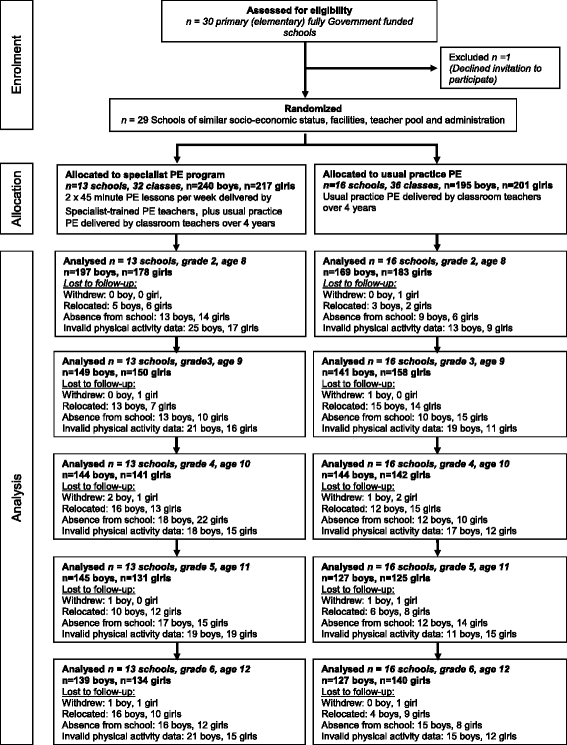Outcomes of a four-year specialist-taught physical education program on physical activity: a cluster randomized controlled trial, the LOOK study
- PMID: 27267965
- PMCID: PMC4897937
- DOI: 10.1186/s12966-016-0388-4
Outcomes of a four-year specialist-taught physical education program on physical activity: a cluster randomized controlled trial, the LOOK study
Abstract
Background: The objective of this study was to investigate the effect of a 4-year specialist-taught Physical Education (PE) program on physical activity (PA) among primary school children.
Methods: A 4-year cluster randomised controlled trial was conducted in children (initially aged 8 years) from 29 primary schools (13 Intervention, 16 Control). Intervention students (N = 457) received 2 × 45 min PE lessons per week from specialist-trained PE teachers (68 lessons per year, 272 lessons over 4 years). Control group students (N = 396) received usual practice PE from generalist classroom teachers. PA during PE lessons was examined using the System for Observing Fitness Instruction Time (SOFIT). Pedometers (steps/day) were worn for 7 days each year, and accelerometers were worn concurrently in the final two years to assess moderate to vigorous (MVPA) and sedentary activity. Linear and generalized mixed models were used to determine differences in Intervention and Control student PA and the proportion of students meeting PA guidelines.
Results: The intervention increased SOFIT-observed student MVPA during PE lessons by 6.5 mins (16.7 v 10.2, p < 0.001). Within intervention schools, participants increased their whole-day step counts (boys = 449 [CI,140 to 756]; girls = 424 [CI,222 to 626]) and minutes of MVPA (boys = 8.0 [CI,6.8 to 9.2]; girls = 3.5 [CI,1.7 to 5.4]) on PE days. However, compared to the Control group the Intervention did not: increase habitual steps/day or MVPA when averaged over 7 days; elicit greater improvements in these measures over time; or increase the odds of meeting step/day or MVPA recommendations. At age 11 years Intervention group boys were 20 mins less sedentary per day (380 [CI,369 to 391] vs 360 [CI,350 to 369]) and this effect was sustained at age 12 years.
Conclusions: Well-designed specialist-taught PE can improve student PA during PE lessons. However for PE to be a significant contributor to improving habitual PA in pre-adolescent children, daily classes are likely to be required, and even this would need to be supplemented with a wider multicomponent strategy. Our finding of a reduction in sedentary time among Intervention boys warrants further investigation into the potential role PE could play in influencing sedentary behaviour.
Keywords: Intervention; Physical activity; Physical education; RCT; School.
Figures
Similar articles
-
Objectively evaluated physical activity and sedentary time in primary school children by gender, grade and types of physical education lessons.BMC Public Health. 2018 Aug 2;18(1):948. doi: 10.1186/s12889-018-5910-y. BMC Public Health. 2018. PMID: 30068319 Free PMC article.
-
Validation of an observation tool to assess physical activity-promoting physical education lessons in high schools: SOFIT.J Sci Med Sport. 2018 May;21(5):495-500. doi: 10.1016/j.jsams.2017.09.186. Epub 2017 Oct 2. J Sci Med Sport. 2018. PMID: 29017834
-
Initial Outcomes of a Participatory-Based, Competency-Building Approach to Increasing Physical Education Teachers' Physical Activity Promotion and Students' Physical Activity: A Pilot Study.Health Educ Behav. 2018 Jun;45(3):359-370. doi: 10.1177/1090198117731600. Epub 2017 Sep 19. Health Educ Behav. 2018. PMID: 28927304
-
State laws governing school physical education in relation to attendance and physical activity among students in the USA: A systematic review and meta-analysis.J Sport Health Sci. 2021 May;10(3):277-287. doi: 10.1016/j.jshs.2020.09.004. Epub 2020 Sep 19. J Sport Health Sci. 2021. PMID: 32961302 Free PMC article.
-
Evidence synthesis - Where are children and adults physically active and sedentary? - a rapid review of location-based studies.Health Promot Chronic Dis Prev Can. 2019 Mar;39(3):67-103. doi: 10.24095/hpcdp.39.3.01. Health Promot Chronic Dis Prev Can. 2019. PMID: 30869472 Free PMC article. Review.
Cited by
-
School-based physical activity programs for promoting physical activity and fitness in children and adolescents aged 6 to 18.Cochrane Database Syst Rev. 2021 Sep 23;9(9):CD007651. doi: 10.1002/14651858.CD007651.pub3. Cochrane Database Syst Rev. 2021. PMID: 34555181 Free PMC article.
-
The Effectiveness of School-Based Interventions on Obesity-Related Behaviours in Primary School Children: A Systematic Review and Meta-Analysis of Randomised Controlled Trials.Children (Basel). 2021 Jun 8;8(6):489. doi: 10.3390/children8060489. Children (Basel). 2021. PMID: 34201145 Free PMC article. Review.
-
A pilot cluster-randomized controlled trial of an audit, feedback, and coaching intervention on compliance with elementary physical education laws and student physical activity during lesson time.Prev Med Rep. 2025 Mar 19;53:103037. doi: 10.1016/j.pmedr.2025.103037. eCollection 2025 May. Prev Med Rep. 2025. PMID: 40212560 Free PMC article.
-
Strategies for enhancing the implementation of school-based policies or practices targeting risk factors for chronic disease.Cochrane Database Syst Rev. 2017 Nov 29;11(11):CD011677. doi: 10.1002/14651858.CD011677.pub2. Cochrane Database Syst Rev. 2017. Update in: Cochrane Database Syst Rev. 2022 Aug 29;8:CD011677. doi: 10.1002/14651858.CD011677.pub3. PMID: 29185627 Free PMC article. Updated.
-
Physical activity promoting teaching practices and children's physical activity within physical education lessons underpinned by motor learning theory (SAMPLE-PE).PLoS One. 2022 Aug 1;17(8):e0272339. doi: 10.1371/journal.pone.0272339. eCollection 2022. PLoS One. 2022. PMID: 35913904 Free PMC article. Clinical Trial.
References
-
- Hardman K. Physical education in schools: a global perspective. Kineziologija. 2008;40:5–28.
-
- Morgan P, Bourke S. Non-specialist teachers’ confidence to teach PE: the nature and influence of personal school experiences in PE. Phys Educ Sport Pedagog. 2008;13:1–29. doi: 10.1080/17408980701345550. - DOI
-
- Blair R, Capel S. Primary physical education, coaches and continuing professional development. Sport Educ Soc. 2011;16:485–505. doi: 10.1080/13573322.2011.589645. - DOI
Publication types
MeSH terms
LinkOut - more resources
Full Text Sources
Other Literature Sources
Medical


